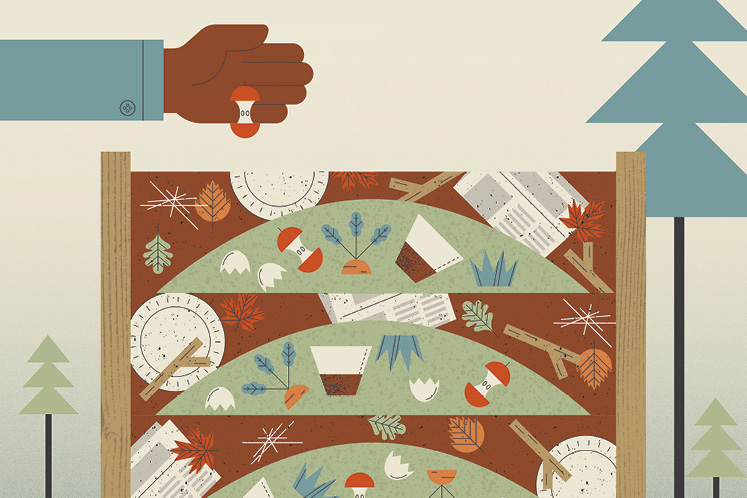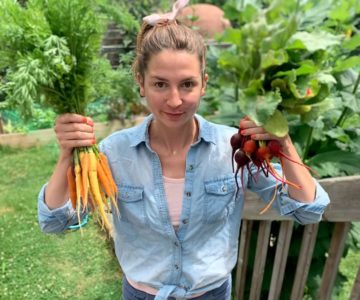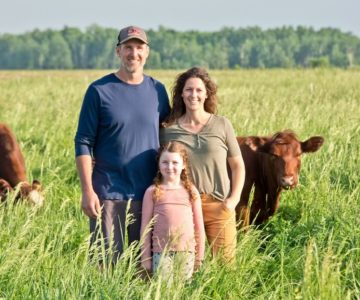Compost Confidential
The art and science of breaking down kitchen and yard waste to create your own blend of nutrient-rich natural fertilizer.
Every seasoned gardener knows that one of the secrets of robust growth is rich, dark compost. If you have a rural property, consider making your own. It may be easier than you think.
“Composting can sound complicated as there is some science involved in creating it,” says Jamie Richards, owner of Am Braigh Farm in Mono. “The main thing to keep in mind is everything that goes into your compost is organic, and everything organic breaks down.”
It all begins with collecting green and brown materials (greens are abundant in nitrogen while browns are full of carbon and carbohydrate-rich). Greens include plant material and cuttings, oil-free vegetable and fruit kitchen scraps, coffee grounds, grass clippings and sheep, cow or horse manure, says Mono-based gardening expert Julia Dimakos.

Breaking down kitchen and yard waste lets you create your own blend of nutrients. Illustration by Ruth Ann Pearce.
Cardboard, newspaper, dry fallen leaves, shredded paper, paper egg cartons, straw, hay and eggshells are considered browns. When this matter is exposed to the oxygen in the air, micro-organisms such as bacteria and fungi get to work, digesting and breaking it down. To keep pests away, both Richards and Dimakos recommend leaving dairy and meats out of the mix.
Compost containment
There are a few schools of thought on where to house your compost heap. If you live in the country, Dimakos recommends creating your own compost structures. She currently has three simple four-foot by four-foot-square compost boxes she built out of wood planks. Though several piles are not essential, having three enables you to rotate the piles so one is always ready, another will be ready soon, and the third is a working pile.
Others erect sturdy bins made of chicken wire, cinder blocks or even trash cans perforated on the bottom. Make sure they are elevated off the ground or lined with biodegradable material such as paper or composting bags that will ensure airflow and drainage. A freestyle open pile directly on the ground will also work – and welcome helpful worms.
Tending your compost
What’s the best recipe for success? Include four times as much brown material as green and layer the two lasagne-style, says Dimakos. To start your pile, the bottom should be a brown layer, followed by green and so on. “Too much green material will turn your pile to sludge, while too much brown will cause the pile to go dormant,” she cautions.
This layering keeps odours neutralized, which stops animals from sniffing around, while a sludgy heap smells intensely foul because it emits ammonia and methane. “I top my greens immediately with shredded paper or dry shredded leaves,” says Dimakos.
This process causes the compost pile to heat up – temperatures can reach 130 F (about 54 C) or higher during peak decomposition – until the oxygen is depleted. To keep on track, invest in a compost thermometer to help you know if your pile is active. Moisture is key, too. If the pile is dry, water once a week to aid decomposition.
When the pile cools off and becomes inactive, Richards recommends turning the compost with a shovel or pitchfork to reintroduce oxygen, allowing the process to repeat. “If after turning the pile, it stops heating, this typically signals your compost is complete and ready to use. It should have a sweet smell about it. That’s when you know it’s done,” Dimakos says.
The final product
In an active compost system, in which the brown-to-green ratio is well-maintained, the moisture level is consistent and the temperature rises and falls, garden compost may be ready within two to three months, Dimakos says. But even in a passive compost system without much intervention, compost can still be ready within a year. Just make sure the process is complete before you use it.
“Compost that has not broken down can burn your plants’ roots because there is too much nitrogen,” says Richards. “It can also take nitrogen out of the soil to further facilitate the decomposition, which can slow the growth your garden.”
Once you start using your homegrown compost, expect better growth and less yellowing of vegetable and flower plants, though not immediately. “Over a few years, you will notice your gardens are growing better,” says Richards.
Related Stories

How Does Your Garden Grow?
Mar 29, 2022 | | LeisureCreating your first vegetable garden can seem like a daunting task. Here’s a beginner’s guide to choosing the right spot, the top crops and enjoying the fruits (well, vegetables) of your labour.

Regenerative Agriculture Puts the Soil First
Jun 22, 2021 | | FarmingHow cover crops, crop rotation and using livestock to fertilize fields puts local farmers on the front lines in reducing climate change.








